The 40th anniversary of the Falklands War has brought back different memories. For some, it is the powerful and traumatic flashbacks of being in an unexpected war so many thousands of miles from home, and yet defending British territory; for others, it’s the memory of watching the drama unfold on television. But for me it’s recalling one of my favourite places in the world, an archipelago of windswept islands which, during my visit in 1974, felt like an idealised version of Britain stuck in a time warp somewhere in the first half of the 20th century, a place where, to make a phone call, you cranked a handle and asked the operator for a number. Sometimes the response would be: ‘Oh Mike has just gone to visit the Johnsons. I’ll put you through to them, shall I?’ There was no television and no newspapers, just a few hours each day of the local radio station.
After nearly two years of backpacking through South America, even my American husband George was homesick for England, and the thought of Christmas in a British colony was irresistible, especially as it was so easy to get there: twice-weekly flights from Argentina cost about £30. From the moment we stepped into the Nissen hut, which served as an airport terminal, to be stamped in by a British official sitting under portraits of the Queen and Prince Philip, we knew we’d made the right choice. Our only plan was to stay for a week, have a proper Christmas dinner and see a few penguins. We left after a month, having eaten two Christmas dinners and spent days observing the antics of five different species of penguin.
Christmas in Stanley
We arrived, as was our custom, with no pre-arranged accommodation. Our fruitless journey around Stanley looking for somewhere affordable to stay ended with us drinking tea in a cosy kitchen, listening to the following one-sided telephone conversation: ‘All they want is bed and breakfast… They seem quite nice… No, they’re not very big… I don’t think so – you’re not Jehovah’s Witnesses are you? All right, I’ll send them along.’ And along we went to meet 84-year-old Mrs Williams who eyed us dubiously and said she’d put us up for a week ‘as long as I keep going.’ And keep going she did, cooking us enormous breakfasts on her peat stove – including on one occasion a huge penguin egg omelette – to the steady accompaniment of mutters and grumbles. She was impervious to our offers to help and to our expressions of delight at her homeland. ‘Penguins, penguins, that’s all I ever hear from you two. One day you’ll come in flappin’ like one!’
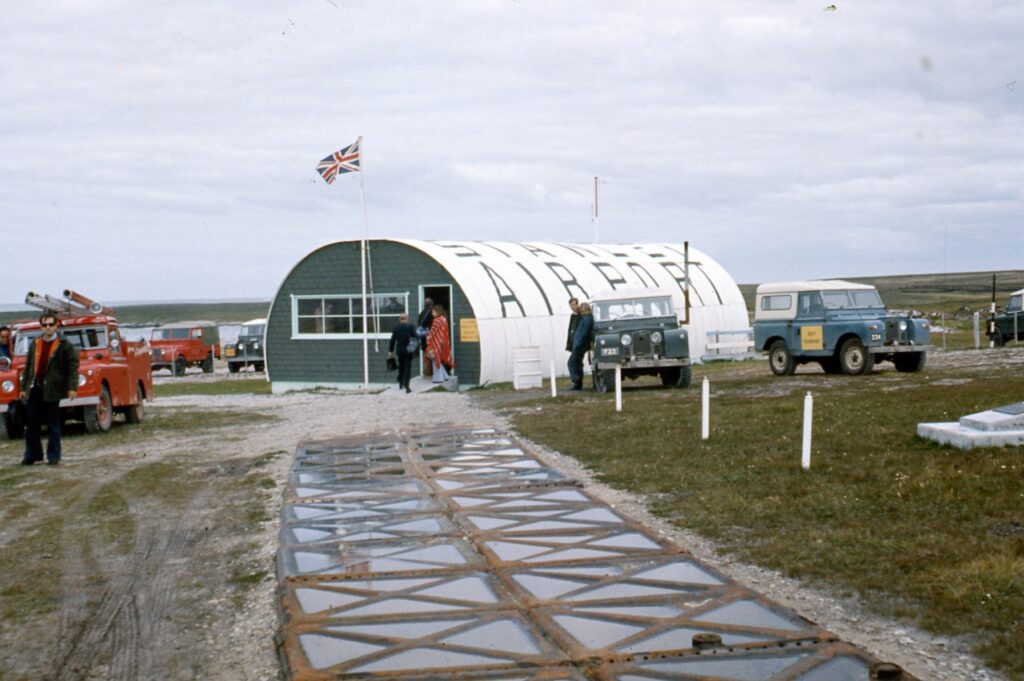
Our first few days were taken up with exploring Stanley and meeting the friendly residents. Having found our plans for a proper Christmas dinner dashed when we discovered that the Upland Goose was fully booked, we were rescued by a British geologist who invited us to join his family for their traditional festive picnic. On Christmas Day morning we took a long walk to work up an appetite, returning to the house to change out of our hiking clothes. We found Mrs Williams muttering in her kitchen, enveloped in delicious cooking smells. Before heading out to meet our hosts, we called in at the kitchen to explain where we were going. ‘Aren’t you staying for dinner then? I’ve got it all ready for you!’ There was nothing for it but to eat two traditional Falkland Christmas dinners of spring lamb with all the trimmings – one in Mrs Williams’s dining room, and the other propped up against a Land Rover, so full we were barely able to breathe. It was the only time in my life that anyone has had cause to comment on my small appetite. Afterwards I wondered if I would live, let alone be fit to take part in the next day’s Boxing Day Races.
Everyone comes to Stanley for the Boxing Day Races, we were told. They arrived from all over the outlying farms on or in whatever transport was available: horseback, motorbike or Land Rover. There were no roads in the ‘camp’ (the local term for the countryside), just tracks. As visitors, we were encouraged to take part. Horse races alternated with foot races, and the bookies did a thriving business.
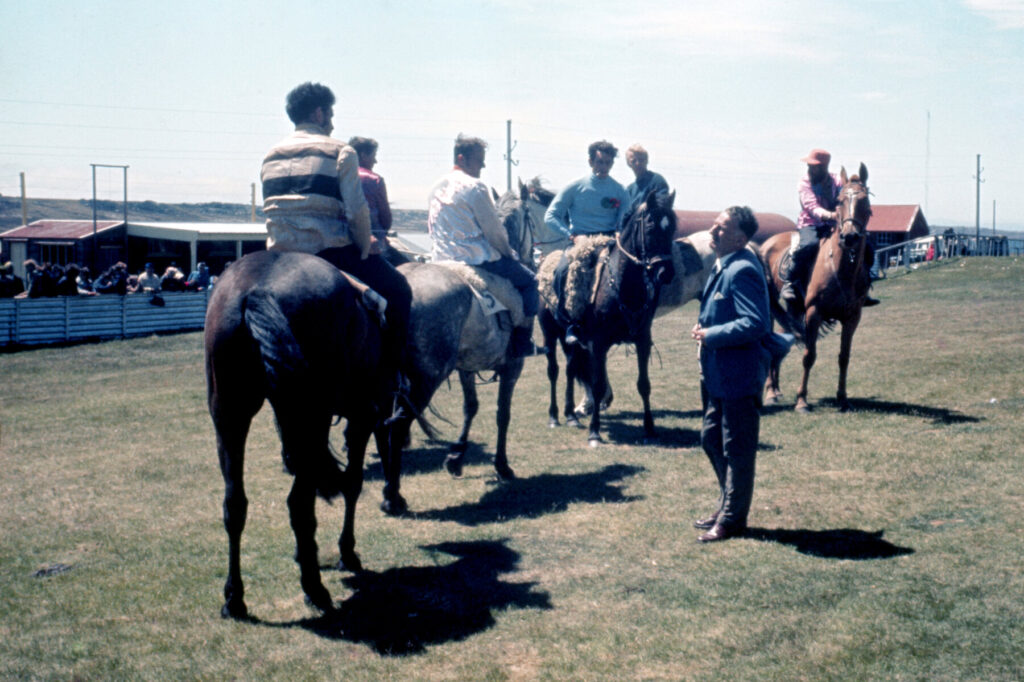
Originally the horse races were just for the shepherds’ ponies, but some thoroughbreds had been imported making for a diverse, and somewhat unfair, field. There were no thoroughbreds in the foot races – anyone could enter the sack race, the three-legged race or, given the right credentials, the over-60s handicap. We entered the three-legged race and came last.
Penguins, penguins, penguins
After Christmas it was time to venture further afield to see more penguins. We’d already visited the nearest rookery of gentoos and also Magellanic penguins, which the islanders called ‘jackass’ because of their donkey-like bray. These penguins live in burrows and, until the 1960s, had suffered the indignity of having their eggs hooked out with a wire coathanger during Egging Week each October. Where even chickens are scarce, penguin eggs make an adequate alternative – although somewhat fishy in flavour.
The species we most wanted to see were the jaunty rockhopper and macaroni penguins, and the stately king penguins which breed in only one place in the archipelago. To view the rockhoppers, our friends in Stanley suggested that we got ourselves stranded on uninhabited Kidney Island, which had a hut for researchers. They recommended a boatman who would drop us off on New Year’s Eve and pick us up again on 3 January. For two days we would be completely alone with no means of getting help in case of an accident. But Mike, the boatman, told us not to worry. ‘If you need help, set fire to the tussock grass and the lighthouse keeper will report it.’ Preparing for Kidney involved an expedition to the one grocery shop in Stanley that stocked British goodies, which arrived once a month on the supply ship. Along with basic provisions we bought a vastly expensive bottle of wine to see in 1975, and – oh joy – a Crosse & Blackwell tinned steamed pudding with sultanas.
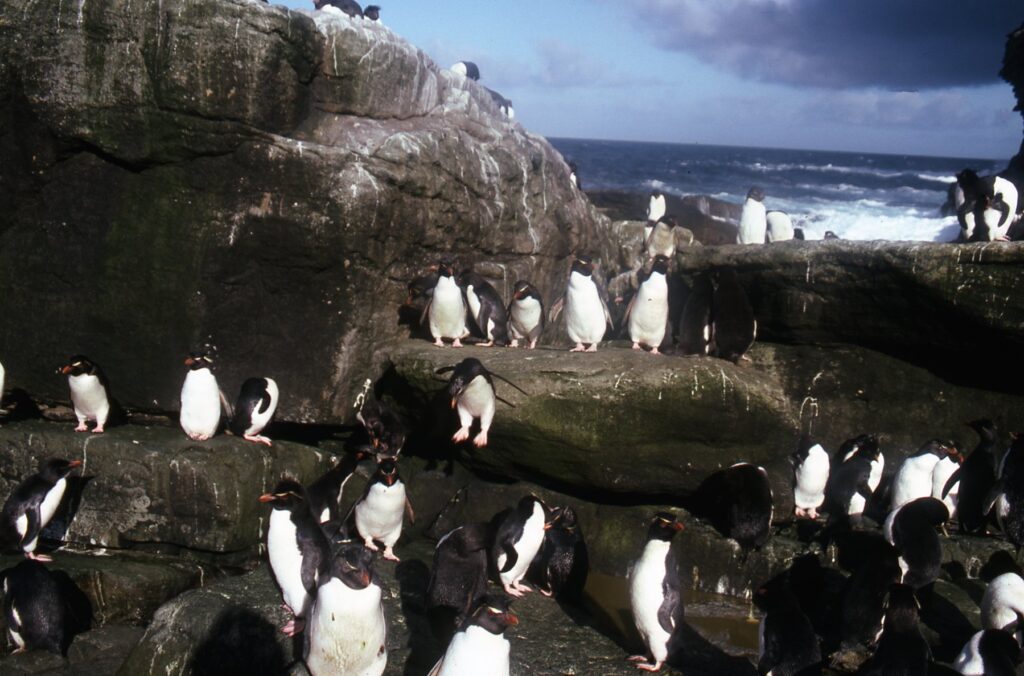
The hut had a good supply of peat for warmth and cooking, and bunk beds. If Christmas had been one of the best ever, this New Year was certainly the best. Each day we sat quietly watching the rockhoppers live up to their names by making their way up the steep rock face to their chicks and waiting mates. Often a huge wave washed them back into the sea and one blood-soaked fellow showed that injuries can happen. The flamboyant macaroni penguins were just a little bigger with prominent golden crests. To reach the rookery we had to make our way through the head-high tussock grass, either jumping from clump to clump or, in our borrowed wellingtons, squelching through the glutinous mud mixed with guano, with the risk of stepping on a dozing elephant seal. The boots also protected our legs from the jabs of furious penguins, which we sometimes met on the approach to the nest site.
Then there was the walk to Volunteer Point to see the king penguins. We anticipated that the 45 miles would take two or three days, but it turned into four days – not because we were tired, but because we couldn’t say no to such generosity. No sooner had we left Stanley than word got around that ‘two birdwatchers’ were on their way. After each night’s stay, we’d barely started walking before we’d see a Land Rover bouncing towards us with an invitation to the next settlement.
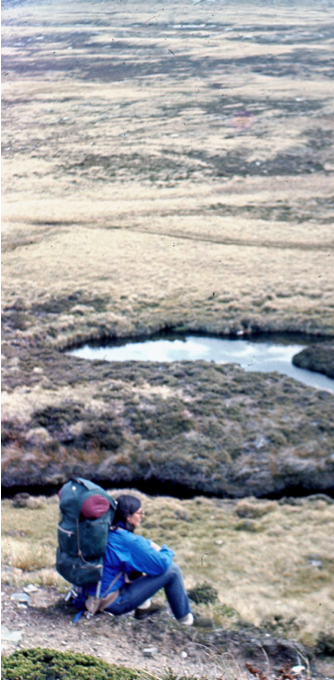
We had our tent and provisions but who’s going to turn down a comfy bed and massive meals after a year of travelling on $5 a day? Besides, it was a unique opportunity to learn about life on the ‘camp’ (derived from the Spanish campo; islanders had also adopted the Argentine greeting ‘Che’ which is the equivalent of ‘mate’).
Life on the ‘camp’
Settlements consisted of the Big House, where the manager lived, and a few shepherd’s cottages along with the Cookhouse where meals were taken. Self-sufficiency was essential in the roadless camp. A cow was kept for fresh milk (which was unobtainable in Stanley) and a few chickens for eggs which helped relieve the monotony of ‘365 meat’ – mutton, eaten every day. Vegetables grew well, despite the constant wind, and a reliable source of fuel for cooking and heat came from peat.
There was no doubt that the highlight of the day on every sheep station – and in Stanley – was the radio doctor. Smoko, the mid-morning break, was timed so that the family could settle round the radio to listen in to their neighbour’s symptoms and speculate on the cause. A medicine chest kept at the Big House dealt with most ailments and there was a cottage hospital in Stanley, but islanders with serious conditions were sent to Argentina. It’s worth mentioning that throughout the 1970s the Argentine government worked hard at winning hearts and minds, not only with free medical care but university scholarships as well. Education was not rated highly with the Kelpers (those born in the Falklands). Who needed it? Their skill in shearing a sheep and baling up the wool in record time was far more valuable than the three Rs. Children were taught by a volunteer teacher (often a VSO from Britain) who left them with a pile of homework before moving on to the next settlement.
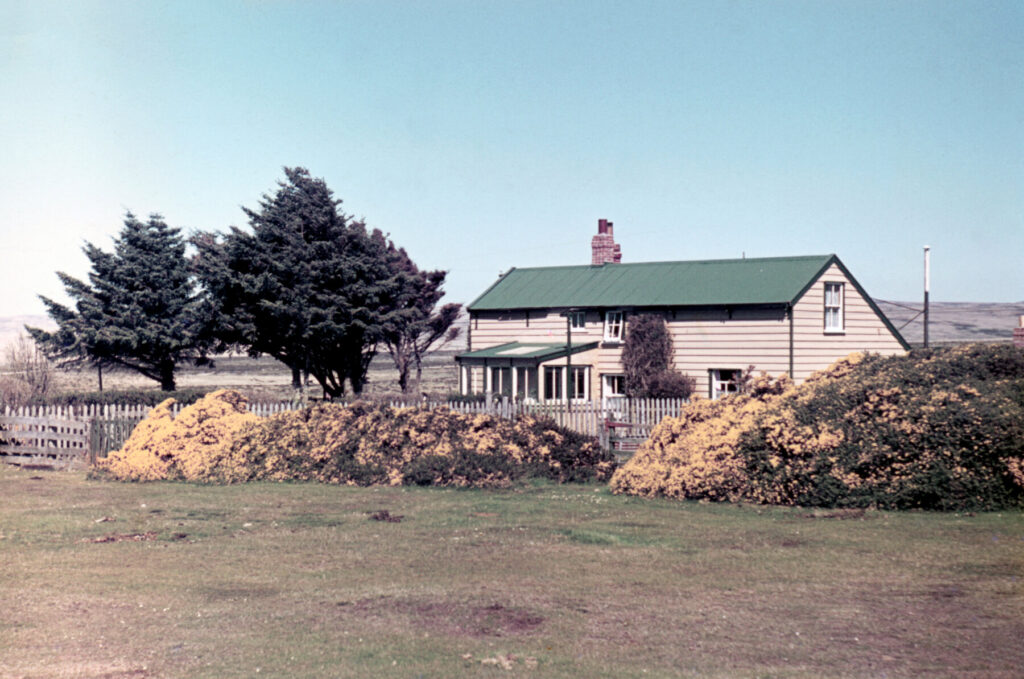
Another popular pastime, as in all rural communities, was complaining about the government and, specifically, The Falkland Islands Company, which before the war owned half the land but did little to make life easier for the Kelpers, who were virtually tied to their sheep farms and had to shop in the company store. This neglect was one of the factors that precipitated the war. Intelligence had convinced Argentina that there would be little resistance to their takeover.
I went back in December 1981 in very different circumstances – leading a tour for an American company. While waiting to board our flight in Comodoro Rivadavia, I chatted to the British Ambassador in Buenos Aires who told me it was his duty to visit the Falklands from time to time to make sure all was well – a visit that he much enjoyed. Argentina invaded the Falkland Islands less than four months later.
I have not been back. Covid prevented a planned return in 2020, but I know that much has changed. Marcel Theroux, writing in The Telegraph in April, describes how owning the fishing rights around the islands has brought great prosperity, a situation unimaginable in 1974. The population has doubled from 1,800 when we were there to over 3,000, and it’s multi-ethnic. Again, something unimaginable before the war. I remember Mrs Williams’s expression when she told us about some Americans, perhaps Peace Corps volunteers, who had asked to stay with her. ‘One of them was a darkie,’ she said, her eyes wide at the very thought. ‘I don’t think I’d like that.’
So a lot has changed, mostly for the better. But I treasure the memory of this group of islands, which felt so familiar and yet so utterly different all those years ago.
More information
For more information, check out our guide to the Falkland Islands: